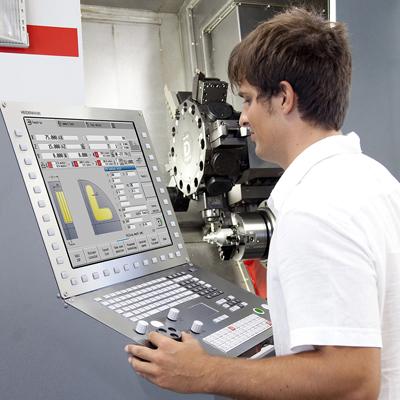
HEIDENHAIN's top-of-the-line lathe control, the CNC PILOT 640, offers enhanced functions and new hardware. These features include the inclusion of smart.TURN, a dialogue guidance system that helps the operator structure the program and define technology data, machining strategy and global data settings in an easy mode. Further, the CNC PILOT 640 has options for full-surface machining with C or Y axis and dual-spindle operation. Fast data transfer and communication with outside devices are also possible with this lathe control.
New end-user features include the complete support of the opposing spindle during automatic work-plan generation in the TURN PLUS mode, better definition of the cut-off point and pick-up devices and an enhanced fixture dialog. Also, the ICP editor allows the parameterization of holes and threads by the user when including contour elements.
The machine builder will reportedly welcome HEDEINHAINs new generation of main computers with more powerful processors and performance reserve for future expansions. The CNC Pilot 640 now has software that is perfectly suited for its hardware innovations. Furthermore, the memory card comes with a faster S-ATA protocol ("CFast") for short access times during startup. Finally, more languages are included in OEM cycles and the machine builder can define work-space limits in the inclined workplane.
In the DIN PLUS mode, cycles can be assigned to contour sections and functions can control special machine components. DXF- and other externally created files can be imported and tested in graphic simulations. A 19-inch TFT color flat-panel display adds to the user friendliness and the all digital design of HEIDENHAIN controls ensures easy diagnostics and noise-free operation.
Another benefit of the CNC PILOT 640 is that it has an add-on for multiple drilling and milling processes on the end face and lateral surface which is usable in one machine setup. As an option, the lathe control has a teach-in mode for simple, non-recurring tasks, rework or thread repair. For example, the CNC PILOT remembers the position and spindle angle when re-cutting a thread. It also automatically calculates the number of cuts for roughing and recessing. All this is complemented by a comprehensive tool and technology database that takes account of tool wear, turret assignment and all other parameters that define tools and workpieces.
Lastly, high contour accuracy is guaranteed by the versatile CNC PILOT 640, as it can dynamically calculate the contour in advance.
Contact Details
Related Glossary Terms
- computer numerical control ( CNC)
computer numerical control ( CNC)
Microprocessor-based controller dedicated to a machine tool that permits the creation or modification of parts. Programmed numerical control activates the machine’s servos and spindle drives and controls the various machining operations. See DNC, direct numerical control; NC, numerical control.
- fixture
fixture
Device, often made in-house, that holds a specific workpiece. See jig; modular fixturing.
- gang cutting ( milling)
gang cutting ( milling)
Machining with several cutters mounted on a single arbor, generally for simultaneous cutting.
- lathe
lathe
Turning machine capable of sawing, milling, grinding, gear-cutting, drilling, reaming, boring, threading, facing, chamfering, grooving, knurling, spinning, parting, necking, taper-cutting, and cam- and eccentric-cutting, as well as step- and straight-turning. Comes in a variety of forms, ranging from manual to semiautomatic to fully automatic, with major types being engine lathes, turning and contouring lathes, turret lathes and numerical-control lathes. The engine lathe consists of a headstock and spindle, tailstock, bed, carriage (complete with apron) and cross slides. Features include gear- (speed) and feed-selector levers, toolpost, compound rest, lead screw and reversing lead screw, threading dial and rapid-traverse lever. Special lathe types include through-the-spindle, camshaft and crankshaft, brake drum and rotor, spinning and gun-barrel machines. Toolroom and bench lathes are used for precision work; the former for tool-and-die work and similar tasks, the latter for small workpieces (instruments, watches), normally without a power feed. Models are typically designated according to their “swing,” or the largest-diameter workpiece that can be rotated; bed length, or the distance between centers; and horsepower generated. See turning machine.
- milling
milling
Machining operation in which metal or other material is removed by applying power to a rotating cutter. In vertical milling, the cutting tool is mounted vertically on the spindle. In horizontal milling, the cutting tool is mounted horizontally, either directly on the spindle or on an arbor. Horizontal milling is further broken down into conventional milling, where the cutter rotates opposite the direction of feed, or “up” into the workpiece; and climb milling, where the cutter rotates in the direction of feed, or “down” into the workpiece. Milling operations include plane or surface milling, endmilling, facemilling, angle milling, form milling and profiling.
- recessing
recessing
A turning operation in which a groove is produced on the periphery or inside a hole of a workpiece. The grooving tool moves at right angles to the axis of rotation.

